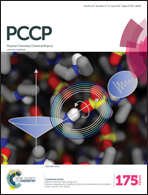Ultrafast differential flexibility of Cro-protein binding domains of two operator DNAs with different sequences
Abstract
The nature of the interface of specific protein–DNA complexes has attracted immense interest in contemporary molecular biology. Although extensive studies on the role of flexibility of DNA in the specific interaction in the genetic regulatory activity of lambda Cro (Cro-protein) have been performed, the exploration of quantitative features remains deficient. In this study, we have mutated (site directed mutagenesis: SDM) Cro-protein at the 37th position with a cysteine residue (G37C) retaining the functional integrity of the protein and labelled the cysteine residue, which is close to the interface, with a fluorescent probe (AEDANS), for the investigation of its interface with operator DNAs (OR3 and OR2). We have employed picosecond resolved polarization gated fluorescence spectroscopy and the well known strategy of solvation dynamics for the exploration of physical motions of the fluorescent probes and associated environments, respectively. Even though this particular probe on the protein (AEDANS) shows marginal changes in its structural flexibility upon interaction with the DNAs, a non-covalent DNA bound probe (DAPI), which binds to the minor groove, shows a major differential alteration in the dynamical flexibility in the OR3–Cro complex when compared to that of the OR2 complex with the Cro-protein. We attempt to correlate the observed significant structural fluctuation of the Cro-protein binding domain of OR3 for the specificity of the protein to the operator DNA.


 Please wait while we load your content...
Please wait while we load your content...